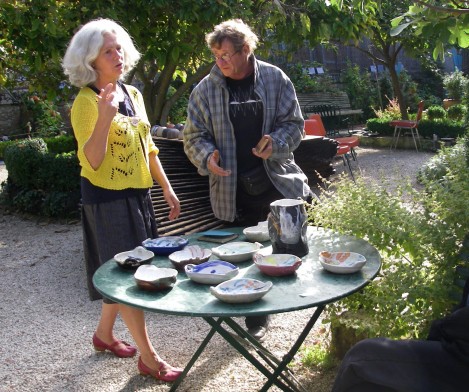
Brigitte Pénicaud leaves her paternal home in t Paris at a very young age in order to live in one of the least populated areas of France, the Berry. She settles with her family in a farmhouse in the middle of a picturesque landscape in the center of the country.
Here she works clay for utilitarian objects and fires them in a wood kiln. Her work expresses her will to freedom. In her ceramic the accident is dominant while painting the objects. What happens during the firing of the clay is also an accident. Drops fall due to the heat of the kiln. One side of the pot burns stronger and darker than the other. When the accident is taken from the oven, the ceramist examines the pot. When she likes it, she keeps it. If the result of the accident doesn’t please her, she throws the object away while still warm from the fire. Her work is total freedom until the object leaves the kiln. After that, it’s rigid selection.
The most obvious characteristic of her work is its tendency to a painting. Many of her plates and pots seem, above all, excuses for her desire to paint her lively colors. She says “I appropriate to myself the sentence of Miró: ‘this is the color of my dreams.'” Brigitte enjoys the freedom of abstract painting, but the shape given by the ceramic continues to be decisive. She applies colors depending on the shape of the object in such a way that the painting would never be the same without the pot.
Brigitte Pénicaud exhibited her work several times in our gallery, for the first time it was at our international debut in 1986, an exhibition with 6 potters from France, among them her husband at the time, Claude Varlan. She returned to exhibit together with Claude in 19.. Terre brute, terre Painte, in 1997 in a group of ceramic friends “Amis de FRance, in 2003 together with Claude Varlan and thier assistant at the time, Nathalie Montarou and in 2011 in a duo exhibition with Anne Bulliot.